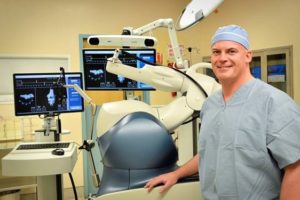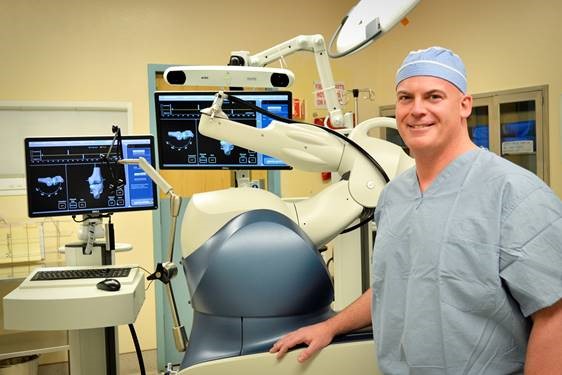In early September, I fortuitously encountered a write up of a novel multimodal knee replacement protocol that significantly reduced opioid use post-surgery. I reached out to Dr. Andrew Wickline, one of the protocol’s authors, and he kindly agreed to chat with me about his groundbreaking non-opioid work. A summary of our conversation is provided below.
 Tell us about yourself – what is your background and what sparked your interest in acute pain management?
Tell us about yourself – what is your background and what sparked your interest in acute pain management?
I am from a small town in West Virginia; I have wanted to be a physician since I was about 13. I ended up applying to medical school my senior year of high school. I attended a combined 7-year BS-MD program at Union College and Albany Medical College (AMC) and have been in upstate NY since 1989. I stayed in Albany for my orthopedic surgery residency and then completed an adult reconstruction fellowship at the Cleveland Clinic. I have been in my current position for the last 18 years. I am the founder of the total joint replacement program at St. Elizabeth Medical Center and started the Accelerated Outpatient Recovery System for the hospital and Apex Surgery Center.
Previously published articles suggest that there is up to a 6% chance of becoming addicted to opioids with a single 24-hour prescription of narcotics. Another study suggests that 10% of all surgical patients per year become addicted to or dependent on opioids. This is a staggering number.
At conferences, I would hear fellow surgical colleagues brag how they got their patient’s opioid prescriptions down to 100 pills. In my practice, I felt that we were below 30 pills, so I began to conduct clinical studies on acute pain management. I did this on a shoestring budget because I work at a community hospital without access to researchers and funding. In my recent study, my colleague and I used a multimodal protocol I created, which included patient education, optimization, and better postoperative rehabilitation to significantly reduce my patients’ opioid use and length of stay following total knee arthroplasty (total knee replacement). We were successfully able to reduce opioid use to less than 10 pills in 86.3% of patients, while 18.9% of patients didn’t require any opioids at all. This is five times lower than the next best published protocol.
Tell us about your hospital.
I work in a community-based hospital with approximately 220 beds. This is where I do most of my surgeries. I also work at an outpatient surgery center about 20% of the time. Regardless of where I treat patients, I strongly encourage them to go home the same day they have surgery. Getting out of the hospital decreases their risk of developing a hospital associated infection or medical error, such as the wrong drugs being prescribed. Our surgery center was the one of first in the state to send people home the same day.
What patient populations do you serve?
My patients are your typical, hardworking Americans who need their hip and/or knee(s) replaced so they can return to their previously active lifestyle. In general, my patients are usually 55 years and older. I do have a few outlier patients that are younger than that, usually because of trauma or a sports injury. Approximately 64% of my patients are Medicare beneficiaries. I do my best to allow every patient the opportunity to go home the same day.
What inspired you to create a non-opioid perioperative pain management experience for patients?
Previous reports have suggested that a patient who was not a previous opioid user has between an 8 – 14% risk of becoming chronically addicted to opioids after knee replacement. In the US, that is somewhere between 80,000 to 140,000 Americans becoming newly addicted every year. Another study suggests that commercial payors typically spend an average of $10,000 dollars/year per covered patient. However, if the patient becomes addicted to opioids, that average payment doubles. Preventing opioid addiction can therefore lead to lower overdose deaths and, as a byproduct, lower insurance costs.
I felt that this could not be allowed to continue. I had long surmised that the conventional model of joint replacement could be improved. I asked my patients what could be better about their postsurgical pain management experience and I listened to their concerns. They led me to completely change the entire surgical process—before surgery and after surgery. I better educated patients, I made them healthier before surgery, and I created a comprehensive pain relief technique that also included eliminating the painful therapy experience so many of my patients complained about. I then followed up and checked with them after their surgery to see what I could do better. Listening to your patient is important. They are your customer.
What positive downstream affects have you seen since you implemented your program?
The 2018 AAOS Rehabilitation textbook states that it takes 10 to 12 weeks of organized therapy to gain 110 degrees of motion in the knee post-surgery. In my study, we saw 109 degrees 3 weeks post-surgery—7 weeks earlier than what is the expected norm. By getting earlier motion, there is a reduced readmission risk because the patient will have a lower chance of getting a blood clot or debilitating scar formation. My patients are also less likely to have complications and are able to miss less days of work post-surgery. In addition, the simple therapy protocol I created allows the average patient to save approximately $720 dollars in therapy copays—a huge benefit to my social security recipients who on average only receive $1341 per month.
What are the next steps/future directions?
We are exploring a range of non-opioid techniques, such as freezing the superficial nerves to manage pain post-surgery. I am also working with several European countries, India, and Australia to incorporate my protocol into their standard of care.
To learn more about Dr. Wickline, please visit his website here: https://www.andrewwicklinemd.com/



